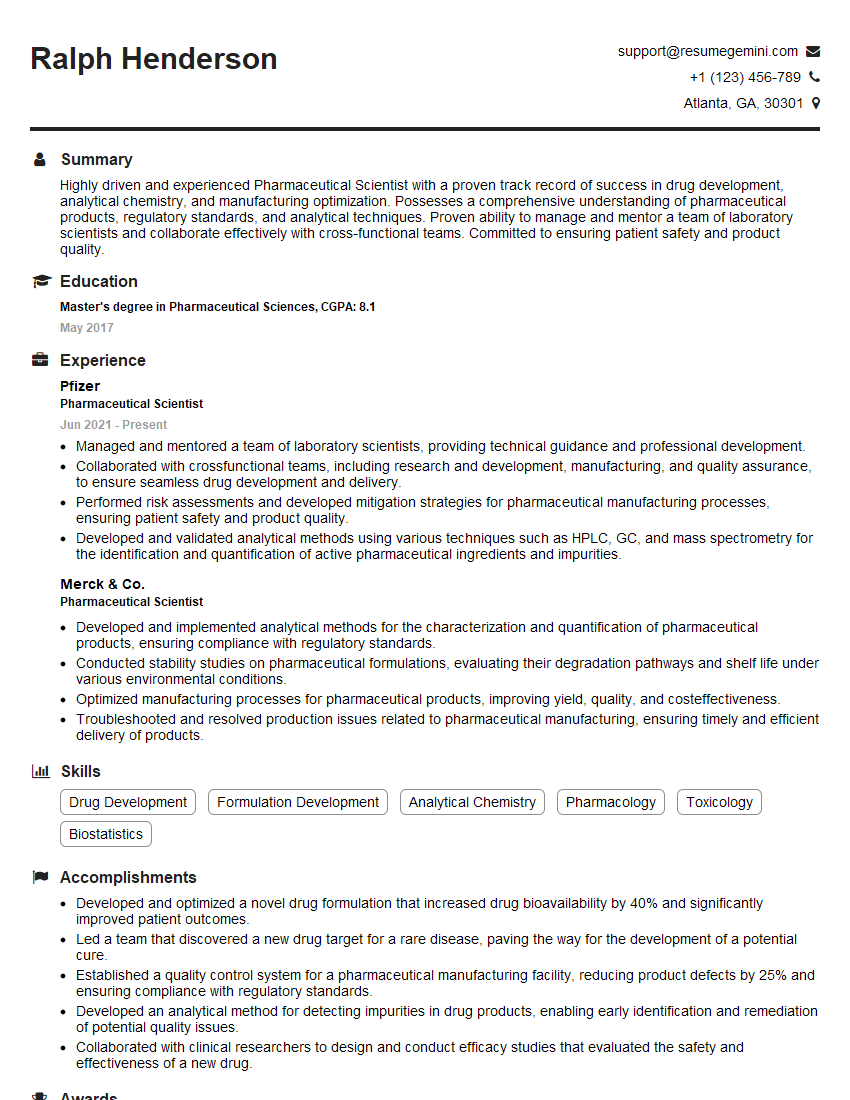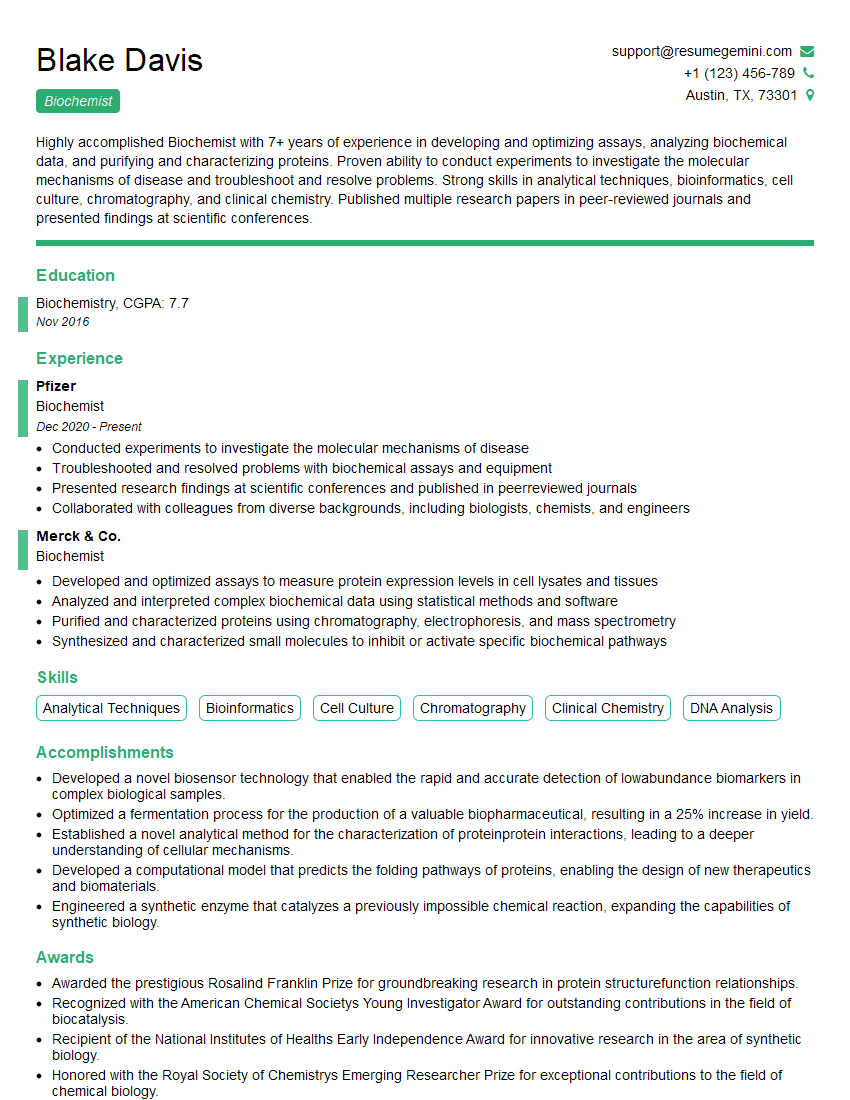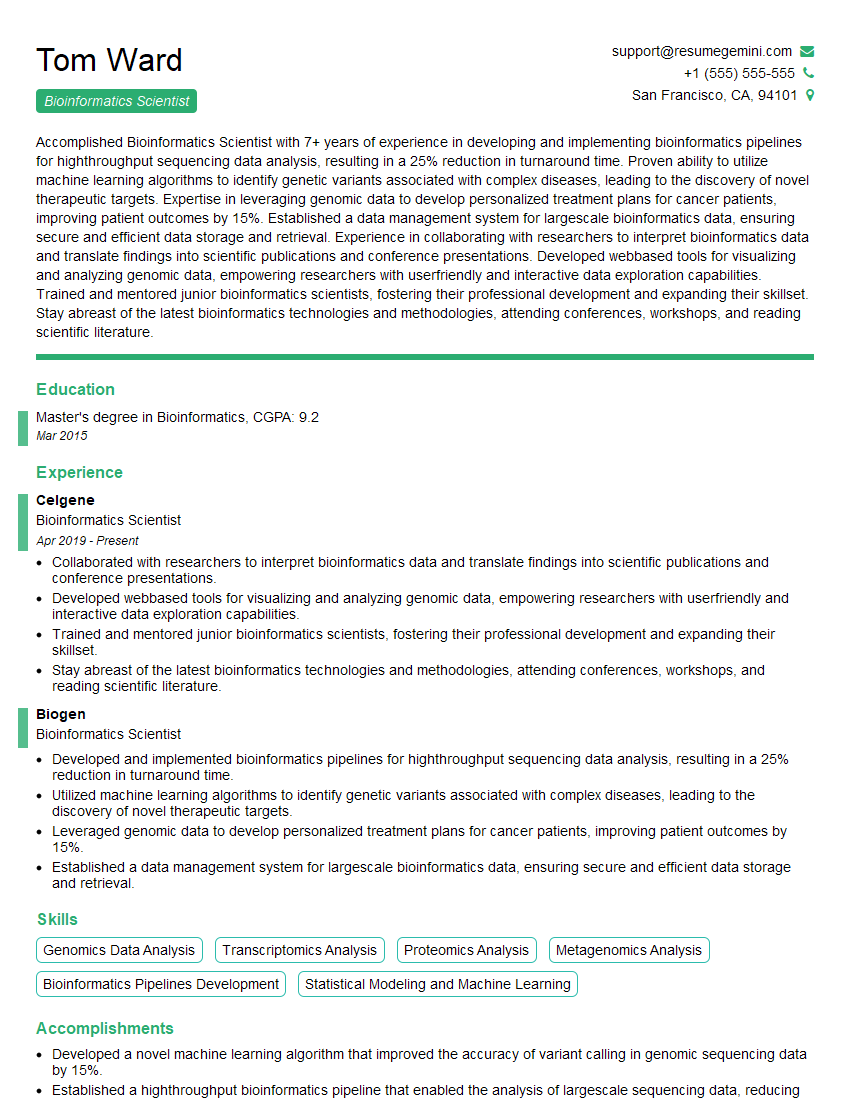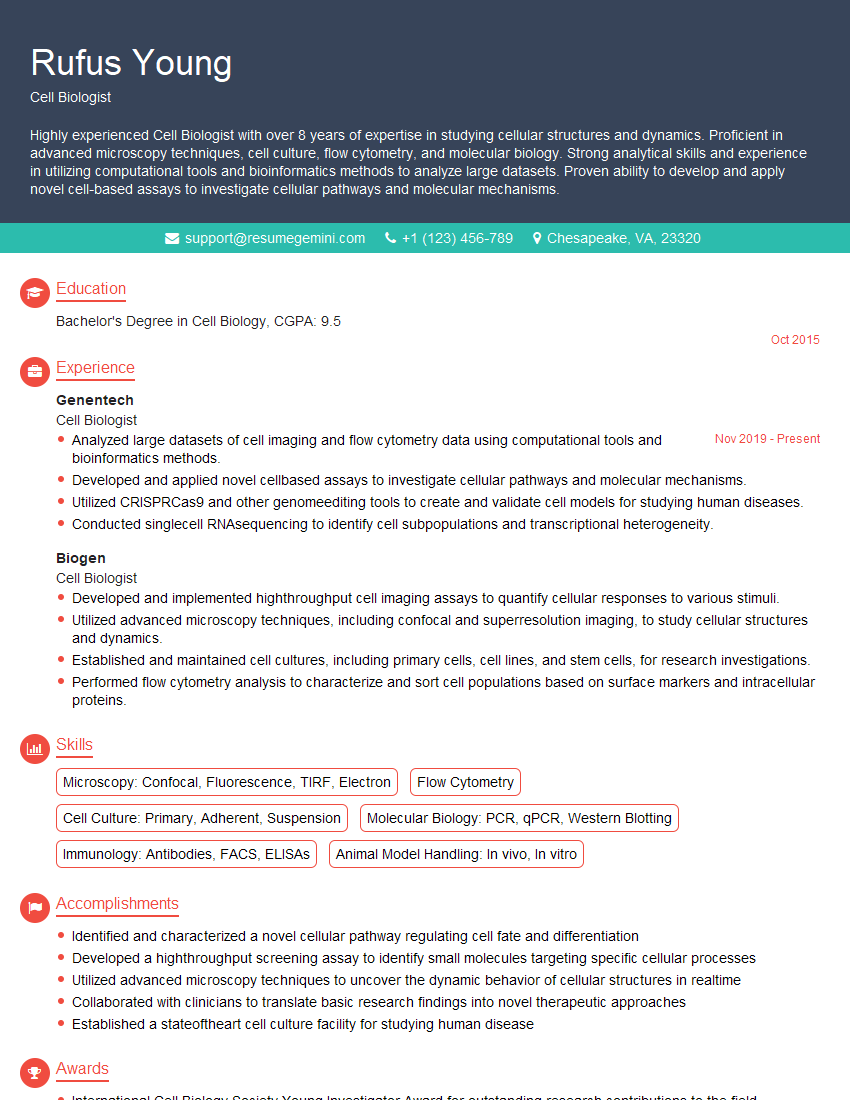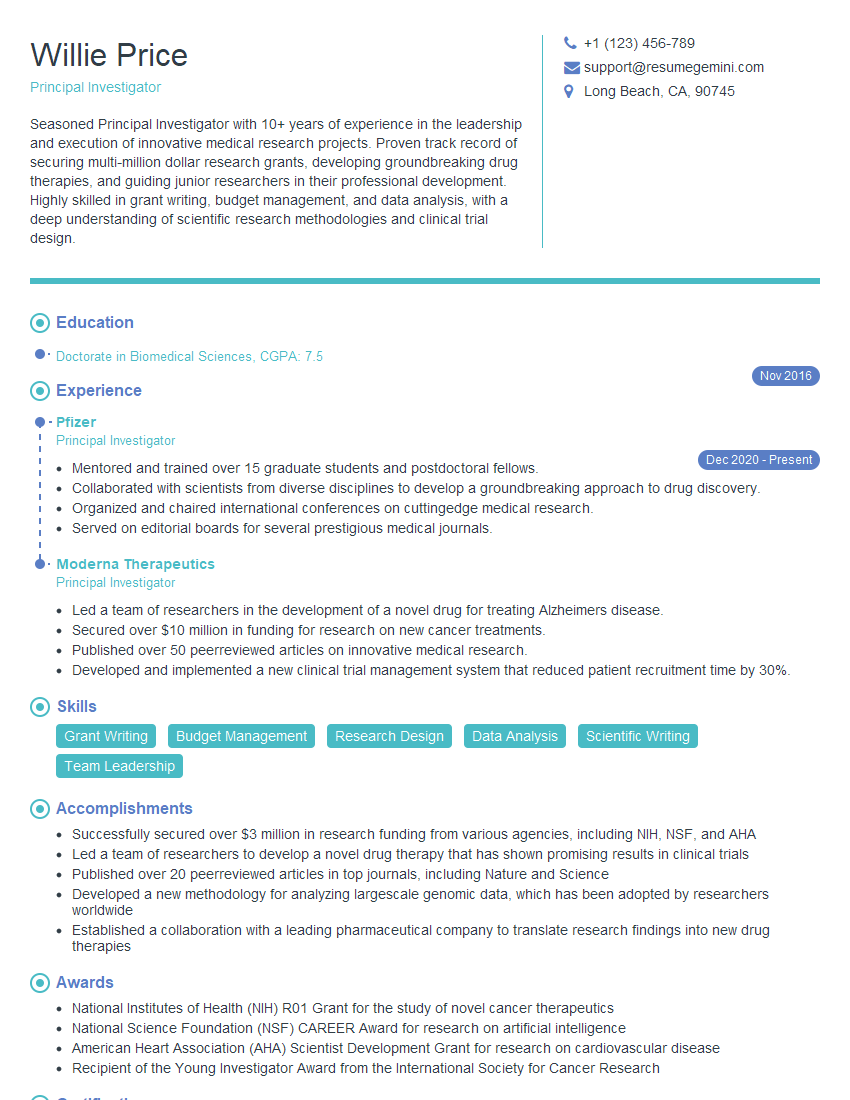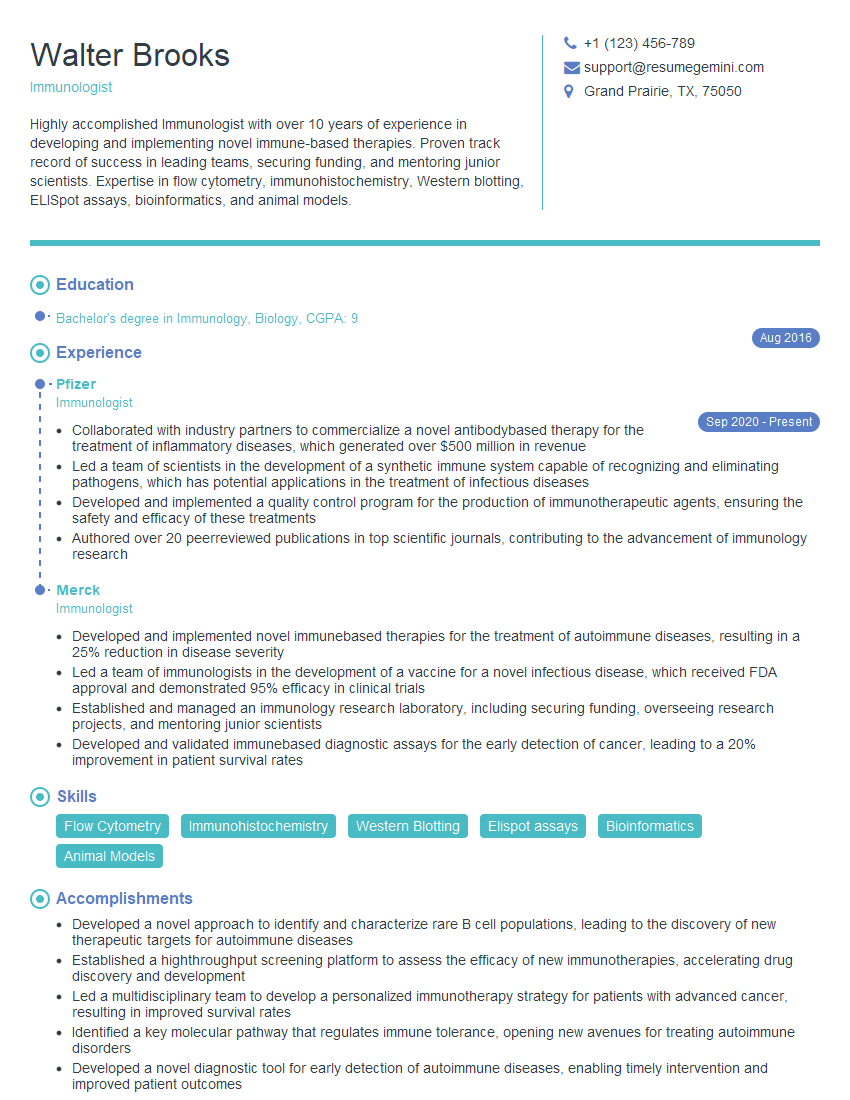Are you ready to stand out in your next interview? Understanding and preparing for Biomedical Research and Product Development interview questions is a game-changer. In this blog, we’ve compiled key questions and expert advice to help you showcase your skills with confidence and precision. Let’s get started on your journey to acing the interview.
Questions Asked in Biomedical Research and Product Development Interview
Q 1. Explain your experience with different research methodologies (e.g., in vivo, in vitro, clinical trials).
My research experience spans various methodologies, each offering unique insights into biological processes and product efficacy. In vitro studies, conducted in controlled laboratory settings using cells or tissues, are crucial for initial screening and mechanistic investigations. For example, I’ve used in vitro assays to assess the cytotoxicity of novel biomaterials before progressing to animal models. In vivo research involves animal models, allowing for a more holistic understanding of drug or device effects within a living organism. In one project, we used a murine model to study the biodistribution and efficacy of a new therapeutic nanoparticle. Finally, clinical trials are essential for evaluating safety and efficacy in humans. I’ve participated in several phases of clinical trials, from designing protocols and managing data collection to analyzing results and contributing to regulatory submissions. This multi-faceted approach ensures a robust understanding of a product’s potential and limitations.
- In vitro: Cell culture, enzyme assays, cytotoxicity testing.
- In vivo: Animal models (mice, rats, larger animals), pharmacokinetic/pharmacodynamic studies.
- Clinical trials: Phase I-IV trials, data analysis, regulatory reporting.
Q 2. Describe your experience with data analysis and statistical software (e.g., SPSS, R, SAS).
Proficient data analysis is paramount in biomedical research. I’m highly experienced with various statistical software packages, including SPSS, R, and SAS. My expertise extends beyond basic statistical analysis to include advanced techniques such as survival analysis, mixed-effects modeling, and machine learning algorithms. For instance, I used R to perform a complex survival analysis on clinical trial data, identifying key prognostic factors and improving our understanding of treatment response. In another project, I utilized SPSS to analyze survey data on patient satisfaction, generating insightful visualizations and conducting statistical tests to validate hypotheses. My ability to select and apply the appropriate statistical method, depending on the nature and structure of the data, ensures accurate and reliable results. I’m also comfortable working with large datasets and implementing efficient data management strategies.
# Example R code for a simple linear regression model <- lm(outcome ~ predictor, data = mydata) summary(model)Q 3. How familiar are you with GLP/GMP regulations?
I have a strong understanding of Good Laboratory Practice (GLP) and Good Manufacturing Practice (GMP) regulations. GLP guidelines ensure the quality and integrity of non-clinical laboratory studies, while GMP regulations govern the manufacturing and testing of drugs and medical devices. My experience includes working in laboratories that adhere strictly to GLP, where meticulous documentation, proper equipment calibration, and rigorous quality control procedures are paramount. I'm also familiar with the GMP requirements for medical device manufacturing, including traceability, validation, and quality assurance protocols. Understanding and complying with these regulations is critical for ensuring the safety and efficacy of biomedical products and for navigating the regulatory approval processes.
Q 4. Explain your experience with design control in medical device development.
Design control is a cornerstone of medical device development, ensuring that products meet their intended use and regulatory requirements. My experience encompasses all phases of the design control process, starting from defining user needs and developing design input specifications to creating design output documentation and verifying and validating the final product. I'm adept at using design control tools such as Design Failure Mode and Effects Analysis (DFMEA) and risk management techniques to proactively identify and mitigate potential hazards. For example, in a recent project, we used DFMEA to systematically assess potential failure modes of a novel implantable device, leading to design modifications that significantly reduced the risk of complications. This systematic approach ensures patient safety and regulatory compliance.
Q 5. Describe your experience with regulatory submissions (e.g., 510(k), PMA).
I possess significant experience with regulatory submissions, including 510(k) premarket notifications and Premarket Approvals (PMA). The 510(k) process is used for devices that are substantially equivalent to legally marketed devices, while a PMA is required for high-risk devices. My role has typically involved compiling and submitting all the necessary documentation, including technical files, test data, clinical trial results, and risk analysis reports. I'm also experienced in interacting with regulatory agencies, such as the FDA, responding to queries, and addressing concerns. Understanding the nuances of these regulatory pathways is critical for obtaining market approval efficiently and effectively. A recent successful 510(k) submission involved carefully demonstrating substantial equivalence to a predicate device through rigorous testing and detailed documentation.
Q 6. How do you manage competing priorities in a fast-paced research environment?
Managing competing priorities in a fast-paced research environment requires a structured and adaptable approach. I use a combination of prioritization techniques, such as Eisenhower Matrix (urgent/important), to identify and focus on the most critical tasks. Effective communication and collaboration with team members are crucial to ensure everyone is aware of priorities and working together efficiently. Clear and realistic project timelines, coupled with regular progress monitoring and proactive risk management, help to stay on track and address potential setbacks promptly. Furthermore, I'm comfortable delegating tasks when appropriate and leveraging the expertise of colleagues to maximize efficiency. Think of it like conducting an orchestra – each instrument (task) has a crucial role, and the conductor (project manager) ensures they play in harmony to achieve a beautiful symphony (successful project).
Q 7. What is your experience with project management methodologies (e.g., Agile, Waterfall)?
My project management experience encompasses both Agile and Waterfall methodologies, each suited to different types of projects. The Waterfall approach, with its sequential phases, is particularly useful for projects with well-defined requirements and minimal anticipated changes. However, for projects that require flexibility and iterative development, the Agile methodology, with its emphasis on iterative sprints and continuous feedback, is more effective. I've successfully led projects using both approaches, tailoring my methodology to the project's specific needs. For instance, I used the Agile methodology for a project involving the development of a novel diagnostic device, allowing for continuous refinement based on user feedback and emerging technological advancements. My experience with these methodologies ensures I can select and execute the most efficient approach for each project, delivering high-quality results on time and within budget.
Q 8. How do you handle unexpected technical challenges during a research project?
Unexpected technical challenges are inevitable in research. My approach involves a systematic problem-solving strategy. First, I meticulously document the issue, including all relevant data and observations. This helps to avoid repeating mistakes and provides a clear record for future analysis. Second, I brainstorm potential solutions with my team, leveraging our collective expertise. We might consult literature, utilize online resources, or reach out to collaborators for expert opinions. Third, I prioritize solutions based on feasibility, cost-effectiveness, and potential impact. We often employ a trial-and-error approach, testing various solutions methodically, and documenting the results of each trial. For example, during a project involving stem cell differentiation, we encountered unexpected cell death. Thorough documentation revealed a subtle variation in media preparation. Adjusting the protocol resolved the issue. Finally, I incorporate the learnings from the challenge into the project's overall methodology to prevent similar issues in the future. This iterative process ensures continuous improvement and strengthens our problem-solving capabilities.
Q 9. Describe your experience with intellectual property protection (patents, trademarks).
I have extensive experience in protecting intellectual property, crucial for translating research into marketable products. My involvement has ranged from initial patent searches and application drafting to negotiating licensing agreements. I'm familiar with various patent types, including utility, design, and plant patents, understanding their scope and limitations. For example, in a previous project involving a novel drug delivery system, we filed a utility patent to protect the core invention's functionality. We also considered trademark protection for the brand name and logo. My understanding of IP extends beyond patents; I'm also knowledgeable about trade secrets, copyright, and know-how protection. I recognize the importance of proactively safeguarding intellectual property to prevent infringement and ensure competitive advantage. The process includes understanding patentability criteria such as novelty, non-obviousness, and utility, which I carefully consider when developing new research or products.
Q 10. Explain your understanding of different drug delivery systems.
Drug delivery systems are crucial for effective therapeutic action. They aim to transport drugs to their target sites, enhancing efficacy and minimizing side effects. Different systems cater to varied needs, utilizing different routes of administration.
- Oral delivery: Convenient but subject to first-pass metabolism.
- Parenteral delivery (injections): Provides precise control but may be uncomfortable.
- Transdermal delivery (patches): Offers sustained release but limited drug loading.
- Inhalation delivery: Suitable for lung diseases but requires precise particle size control.
- Targeted delivery systems (nanoparticles, liposomes): Improve drug targeting and reduce toxicity.
Q 11. How do you ensure data integrity and traceability in your research?
Data integrity and traceability are paramount in biomedical research. We use a combination of strategies to ensure the reliability and validity of our findings. We utilize electronic laboratory notebooks (ELNs) to record all experimental procedures, data, and observations in a secure and auditable manner. Data is regularly backed up to prevent loss. Access control measures are implemented to restrict access based on roles and responsibilities. We adhere to strict protocols for data handling and analysis, including version control for all documents and data files. A comprehensive audit trail allows for tracing the origin and modifications of all data points. For example, each data entry in our ELN is timestamped and linked to the researcher responsible. Any modifications are recorded with a clear explanation. This meticulous approach ensures the highest level of data integrity and enables transparent and reproducible research.
Q 12. What is your experience with risk management in product development?
Risk management is integral to successful product development. I utilize a structured approach incorporating risk identification, analysis, evaluation, and mitigation. We identify potential risks throughout the product lifecycle, from research to commercialization, using tools like Failure Mode and Effects Analysis (FMEA). This involves brainstorming potential failures, assessing their likelihood and severity, and prioritizing mitigation strategies. For example, during the development of a medical device, we identified a potential risk of material degradation affecting device performance. Through risk analysis, we determined that this was a high-severity, moderate-likelihood risk. We then implemented mitigation strategies, including material testing and rigorous quality control checks to reduce this risk. Regular risk assessments are conducted to monitor emerging risks and update our mitigation plans as the project evolves. This proactive approach minimizes the likelihood of costly delays or failures.
Q 13. Describe your familiarity with different types of biomaterials.
Biomaterials are essential components of numerous biomedical devices and therapies. My familiarity spans a broad range, including:
- Polymers: Such as polyethylene glycol (PEG) for drug delivery or polylactic-co-glycolic acid (PLGA) for biodegradable scaffolds.
- Ceramics: Like hydroxyapatite for bone implants due to their biocompatibility and osteoconductive properties.
- Metals: Such as titanium and stainless steel for orthopedic implants, chosen for their strength and biocompatibility.
- Natural biomaterials: Including collagen and hyaluronic acid used for tissue engineering and drug delivery, valued for their biocompatibility and biological activity.
- Composites: Combinations of these materials, offering tailored properties.
Q 14. How do you evaluate the feasibility of a new research idea?
Evaluating the feasibility of a new research idea is a crucial step in resource allocation. My approach involves a structured assessment incorporating several key aspects. Firstly, I assess the scientific merit, reviewing existing literature and determining the novelty and potential impact of the proposed work. Second, I examine the technical feasibility, considering the availability of resources, technologies, and expertise necessary for successful execution. Third, I assess the regulatory and ethical implications, ensuring compliance with relevant guidelines and obtaining necessary approvals. Finally, I conduct a preliminary cost-benefit analysis, evaluating the potential return on investment and aligning it with available funding. For example, when evaluating a new diagnostic tool, we investigated its potential market impact, available technologies for development, regulatory requirements for medical device clearance, and estimated costs versus potential revenue. This multi-faceted evaluation determines whether the research idea is scientifically sound, technically achievable, ethically sound, and economically viable, enabling informed decision-making.
Q 15. Explain your experience with cell culture techniques.
Cell culture is a cornerstone of biomedical research, involving the growth of cells in vitro. My experience spans various cell types, including primary cells and established cell lines. I'm proficient in aseptic techniques to prevent contamination, crucial for reliable results. This includes meticulous sterile procedures like working in a laminar flow hood, using sterile reagents and media, and regularly monitoring cultures for signs of infection.
I've worked extensively with various culture methodologies, such as monolayer cultures in flasks and dishes, and suspension cultures in spinner flasks for cells that don't adhere to surfaces. I understand the importance of optimizing culture conditions, such as media composition, incubation temperature, humidity, and CO2 levels, based on the specific cell type. For example, when working with delicate neuronal cells, I had to maintain precise control of temperature and humidity using specialized incubators to ensure their viability.
Furthermore, I'm experienced in subculturing, which involves transferring cells to fresh media to maintain their growth and prevent overcrowding. I've also performed cell counting using hemocytometers and automated cell counters for accurate quantification. Cryopreservation techniques, including freezing and thawing cells using cryoprotective agents like DMSO, are also part of my routine to preserve cell lines for long-term use.
Career Expert Tips:
- Ace those interviews! Prepare effectively by reviewing the Top 50 Most Common Interview Questions on ResumeGemini.
- Navigate your job search with confidence! Explore a wide range of Career Tips on ResumeGemini. Learn about common challenges and recommendations to overcome them.
- Craft the perfect resume! Master the Art of Resume Writing with ResumeGemini's guide. Showcase your unique qualifications and achievements effectively.
- Don't miss out on holiday savings! Build your dream resume with ResumeGemini's ATS optimized templates.
Q 16. Describe your experience with molecular biology techniques (e.g., PCR, cloning).
Molecular biology techniques form the bedrock of my research. I have extensive experience with polymerase chain reaction (PCR), a vital method for amplifying specific DNA sequences. I'm proficient in various PCR applications, including standard PCR, quantitative real-time PCR (qPCR), and reverse transcription PCR (RT-PCR) for gene expression analysis.
My cloning experience includes designing and executing cloning strategies using various vectors, such as plasmids and viral vectors. This involves restriction enzyme digestion, ligation, transformation, and selection of recombinant clones. For instance, I recently cloned a novel gene into a lentiviral vector for gene therapy research. The process required careful selection of restriction enzymes, optimization of ligation conditions, and efficient transformation into competent bacteria to achieve high cloning efficiency.
Beyond PCR and cloning, I'm also familiar with other crucial techniques like gel electrophoresis for DNA and RNA analysis, DNA sequencing for verifying cloned sequences, and Western blotting for protein detection. These techniques allow me to investigate the molecular mechanisms underlying biological processes and diseases.
Q 17. How do you interpret and present scientific data?
Data interpretation and presentation are paramount to effective scientific communication. My approach begins with a thorough statistical analysis, appropriate to the type of data (e.g., t-tests, ANOVA, correlation analysis). I employ statistical software like GraphPad Prism and R to conduct these analyses and assess the statistical significance of my findings. I avoid over-interpreting results, ensuring conclusions are supported by solid evidence.
When presenting data, clarity and accuracy are paramount. I prefer to use clear and concise visualizations, such as graphs and charts, tailored to the audience. For example, when presenting to a scientific audience, I might use box plots and scatter plots to illustrate statistical distributions and correlations. When presenting to a less technical audience, I might opt for simpler bar charts and line graphs.
Furthermore, I believe in the importance of context. The results are presented within the broader framework of the research question and existing literature, highlighting the implications and limitations of the study. I always strive for transparency and accuracy in my data representation, ensuring that the data speaks for itself.
Q 18. What is your experience with writing scientific publications and reports?
I have extensive experience in writing scientific publications and reports, having authored and co-authored several peer-reviewed publications in high-impact journals. My writing process involves a systematic approach: starting with a clear outline, followed by detailed writing, rigorous self-editing, and collaborative review with co-authors. This iterative process ensures clarity, accuracy, and a logical flow of information.
I'm proficient in adhering to specific journal guidelines, including formatting, citation style (e.g., APA, MLA), and submission procedures. I am familiar with various publication types, including original research articles, review articles, and abstracts for conferences. For example, preparing a manuscript for a high-impact journal requires meticulous attention to detail, including rigorous statistical analysis and a clear articulation of the study's novelty and significance.
Beyond publications, I have also prepared numerous internal reports and presentations detailing experimental results and project progress. Effective communication is key, and tailoring the report's style and detail level to the specific audience is crucial.
Q 19. How do you collaborate effectively with interdisciplinary teams?
Effective collaboration is essential in biomedical research, which often involves diverse expertise. My approach emphasizes open communication, active listening, and mutual respect. I believe in clearly defining roles and responsibilities within the team from the outset, ensuring everyone is on the same page. Regular team meetings, both formal and informal, help to maintain momentum and address challenges proactively.
I value diverse perspectives and actively seek input from team members with different backgrounds. I'm skilled at mediating disagreements and finding constructive solutions. For instance, in a recent project, we faced a technical challenge involving data analysis. By combining my expertise in biostatistics with a colleague's knowledge of advanced computing techniques, we were able to overcome this roadblock efficiently.
Effective communication tools, such as project management software and shared online documents, are also crucial for seamless collaboration, especially in larger teams with geographically dispersed members.
Q 20. How do you stay up-to-date with the latest advancements in your field?
Staying current in this rapidly evolving field requires a multi-pronged approach. I regularly read scientific journals, focusing on those with high impact factors in my area of research. I actively participate in scientific conferences and workshops, both national and international, allowing me to network with other researchers and learn about the latest advancements directly from the source.
I leverage online resources such as PubMed, Google Scholar, and specialized databases to search for relevant publications and preprints. I also follow leading researchers in my field on social media platforms like Twitter and LinkedIn for updates on cutting-edge research and news. Regularly attending seminars and webinars presented by experts in the field also keeps me informed of the latest breakthroughs.
Furthermore, I maintain a strong professional network, both online and offline, to foster discussions and collaborations with colleagues and mentors. Participating in journal clubs, where researchers discuss recent publications, also significantly contributes to my understanding of current trends and new approaches.
Q 21. Describe your experience with budget management for research projects.
Budget management is a critical aspect of research project management. My experience includes developing detailed budgets, justifying costs, and tracking expenditures throughout the project lifecycle. I’m adept at using budgeting software to create comprehensive budget spreadsheets and track spending against allocated resources.
When developing a budget, I start by meticulously identifying all necessary resources, including personnel costs, equipment, reagents, consumables, and publication fees. Then, I conduct thorough research to obtain accurate cost estimates for each item, considering potential contingencies and unexpected expenses. The budget then needs to be justified to funding bodies, highlighting the value and potential impact of the project.
I also regularly monitor budget progress, comparing actual spending to the planned budget. This proactive approach allows for timely identification of potential overruns or underspending, facilitating appropriate adjustments to ensure the project remains within budget. Efficient resource allocation is vital for the successful completion of any research project.
Q 22. How do you prioritize tasks and allocate resources efficiently?
Prioritizing tasks and allocating resources effectively in biomedical research and product development requires a structured approach. I typically use a combination of methods, adapting my strategy based on project specifics and urgency. Initially, I employ a prioritization matrix, such as the Eisenhower Matrix (Urgent/Important), to categorize tasks. This helps quickly identify critical path items demanding immediate attention and those that can be delegated or scheduled later.
Resource allocation follows a similar principle. I consider the project timeline, available expertise (personnel with specific skills), budget constraints, and the potential impact of each task on the overall project goals. For instance, if a crucial experiment requires specialized equipment and expertise, I'll prioritize securing those resources first, even if it means delaying less critical tasks. I also use project management software to track progress, resource utilization, and potential bottlenecks, enabling proactive adjustments to maintain efficiency and meet deadlines.
Finally, regular project review meetings are crucial. These meetings allow for open communication, identification of unforeseen roadblocks, and adjustments to the prioritization and resource allocation plan as needed. Think of it as navigating a ship – you need to constantly adjust your course based on the weather (unexpected challenges) and your destination (project goals).
Q 23. Explain your understanding of different types of clinical trials.
Clinical trials are the backbone of biomedical product development, rigorously testing the safety and efficacy of new treatments and devices. They are broadly categorized into several phases:
- Phase 0: These are very early-stage exploratory studies involving a small number of participants. Their primary goal is to evaluate the pharmacokinetics and pharmacodynamics of a new drug. Think of it as a small-scale test run before the main event.
- Phase 1: Focuses primarily on safety and tolerability, typically involving a small group of healthy volunteers to assess potential side effects and determine safe dosage ranges. This is like a preliminary safety check before large-scale deployment.
- Phase 2: Explores the efficacy of the treatment in a larger group of patients with the target disease. Researchers evaluate the treatment's effectiveness and identify optimal dosages and treatment regimens. This is where we start to gather evidence of effectiveness.
- Phase 3: A large-scale, randomized controlled trial (RCT) designed to confirm the treatment's effectiveness and compare it to existing therapies or a placebo. This phase provides robust evidence to support regulatory approval.
- Phase 4: Post-market surveillance studies conducted after the treatment's approval. They monitor long-term effects, rare side effects, and effectiveness in various patient populations. It's the ongoing monitoring after the product is released to the market.
Each phase has specific objectives and designs, building upon the knowledge and data gathered from previous phases to ultimately determine the safety and efficacy profile of the product.
Q 24. Describe your experience with clinical trial data management.
My experience in clinical trial data management encompasses all aspects, from study design and data collection to analysis and reporting. I'm proficient in using Electronic Data Capture (EDC) systems such as REDCap and Rave, ensuring data integrity and compliance with regulatory guidelines like GCP (Good Clinical Practice). I've worked extensively with databases like SQL to manage and query large datasets, conducting data cleaning, validation, and transformation to prepare data for analysis. My skills also include developing Data Management Plans (DMPs) which detail data handling procedures.
For instance, in a recent project involving a Phase 3 trial for a novel cancer therapy, I was responsible for overseeing data entry, ensuring data consistency across multiple sites, and identifying and resolving inconsistencies. This involved implementing validation checks within the EDC system to minimize errors during data entry and employing regular data quality reports to monitor the data throughout the study. Working with diverse teams across various sites requires excellent communication and collaborative skills, all while ensuring the highest levels of data integrity and patient confidentiality.
Q 25. What is your experience with quality control and quality assurance processes?
Quality Control (QC) and Quality Assurance (QA) are integral to maintaining the integrity and reliability of research and product development. QC focuses on the individual processes and outputs, ensuring they meet predefined standards. QA, on the other hand, focuses on the overall system and processes, ensuring the quality system is effective and consistently delivers high-quality results.
In my work, I've applied QC through rigorous data validation, equipment calibration checks, and adherence to standardized operating procedures (SOPs). I've developed and implemented SOPs in various laboratory settings, ensuring consistency in experimental procedures and data handling. QA is implemented through regular audits of processes, documentation review, and participation in continuous improvement initiatives. For example, I've conducted internal audits of laboratory practices, identifying areas for improvement and implementing corrective actions to enhance data quality and process efficiency. A proactive approach to QC and QA minimizes errors, enhances reliability, and ensures compliance with regulatory standards.
Q 26. How do you identify and mitigate potential risks in a product development project?
Identifying and mitigating risks in product development is crucial for success. I utilize a risk management framework, typically involving these steps:
- Risk Identification: This involves brainstorming potential risks throughout the project lifecycle, considering technical, regulatory, financial, and ethical aspects. Techniques include SWOT analysis, Failure Mode and Effects Analysis (FMEA), and expert interviews.
- Risk Assessment: Each identified risk is evaluated based on its likelihood and potential impact. This often uses a risk matrix to categorize risks as low, medium, or high priority.
- Risk Response Planning: For each risk, a mitigation strategy is developed. This might include risk avoidance (eliminating the risk), risk reduction (minimizing its likelihood or impact), risk transfer (insuring against the risk), or risk acceptance (acknowledging and monitoring the risk).
- Risk Monitoring and Control: Risks are continuously monitored throughout the project, and the mitigation strategies are reviewed and updated as needed. This ensures proactive management of emerging risks.
For example, in a project developing a new medical device, a potential risk could be regulatory approval delays. The risk response could include developing a robust regulatory strategy early in the project, engaging with regulatory bodies proactively, and having a contingency plan in place for potential delays. This systematic approach ensures that potential problems are addressed proactively, maximizing the chances of project success.
Q 27. Explain your understanding of human subject research ethics.
Human subject research ethics are paramount in biomedical research. My understanding is grounded in the ethical principles of respect for persons, beneficence, and justice, as outlined in the Belmont Report. Respect for persons entails obtaining informed consent from participants, ensuring their autonomy, and protecting vulnerable populations. Beneficence involves maximizing benefits and minimizing risks to participants. Justice ensures that the burdens and benefits of research are fairly distributed among different groups.
In practice, this translates to careful review of research protocols by Institutional Review Boards (IRBs), ensuring that all studies adhere to ethical guidelines and regulations. I'm experienced in preparing IRB applications, obtaining informed consent, and ensuring the privacy and confidentiality of participant data. I'm also familiar with ethical considerations related to data sharing and publication. Protecting the rights and well-being of research participants is non-negotiable, and I prioritize ethical conduct in every aspect of my work.
Q 28. How do you ensure the safety and efficacy of a biomedical product?
Ensuring the safety and efficacy of a biomedical product requires a rigorous and multifaceted approach. It begins with robust preclinical studies to evaluate the product's safety and potential efficacy in animal models. This is followed by a series of clinical trials, as described earlier, meticulously designed to assess both safety and efficacy in human populations.
Throughout the development process, rigorous quality control measures are employed at every stage, from manufacturing and testing to packaging and distribution. This includes adherence to Good Manufacturing Practices (GMP) guidelines to ensure consistent product quality and safety. Post-market surveillance is crucial to monitor long-term safety and efficacy, enabling prompt action if any issues arise. Regulatory approval agencies play a vital role, ensuring that only safe and effective products are released to the market. It's a continuous process, requiring vigilance and commitment to the highest standards to protect patient safety and ensure the product meets its intended purpose.
Key Topics to Learn for Biomedical Research and Product Development Interview
- Research Design & Methodology: Understanding experimental design, data analysis techniques (statistical significance, p-values), and the scientific method are crucial. Consider the strengths and weaknesses of different study designs.
- Drug Discovery & Development: Familiarize yourself with the stages of drug development, from target identification and validation to clinical trials and regulatory approval. Understand the challenges and complexities involved at each stage.
- Biotechnology & Biomanufacturing: Grasp the principles of cell culture, protein engineering, gene editing technologies (e.g., CRISPR), and various biomanufacturing processes. Be prepared to discuss scalability and GMP (Good Manufacturing Practices).
- Medical Device Development: Understand the regulatory landscape (FDA guidelines), design control processes, and the stages of medical device development. Be ready to discuss relevant standards and certifications.
- Data Analysis & Interpretation: Develop strong skills in interpreting complex datasets, visualizing data effectively, and drawing meaningful conclusions from experimental results. Practice presenting data clearly and concisely.
- Intellectual Property & Regulatory Affairs: Gain a basic understanding of patents, trademarks, and regulatory pathways for both drugs and medical devices. This knowledge demonstrates your awareness of the business side of biomedical innovation.
- Teamwork & Communication: Biomedical research and development are inherently collaborative endeavors. Be prepared to discuss your experience working in teams, communicating scientific findings effectively, and contributing to a shared goal.
- Problem-solving & Critical Thinking: The ability to identify, analyze, and solve complex problems is essential. Practice approaching challenges systematically and using critical thinking to evaluate different approaches.
Next Steps
Mastering Biomedical Research and Product Development opens doors to exciting and impactful careers, offering opportunities for innovation and contributing to advancements in healthcare. To maximize your job prospects, it's vital to present your skills and experience effectively. An ATS-friendly resume is crucial for getting your application noticed by recruiters and hiring managers. ResumeGemini is a trusted resource that can help you craft a compelling and optimized resume to showcase your qualifications. Examples of resumes tailored to Biomedical Research and Product Development are available to guide your resume creation process, helping you stand out from the competition.
Explore more articles
Users Rating of Our Blogs
Share Your Experience
We value your feedback! Please rate our content and share your thoughts (optional).
What Readers Say About Our Blog
Interesting Article, I liked the depth of knowledge you’ve shared.
Helpful, thanks for sharing.
Hi, I represent a social media marketing agency and liked your blog
Hi, I represent an SEO company that specialises in getting you AI citations and higher rankings on Google. I’d like to offer you a 100% free SEO audit for your website. Would you be interested?




